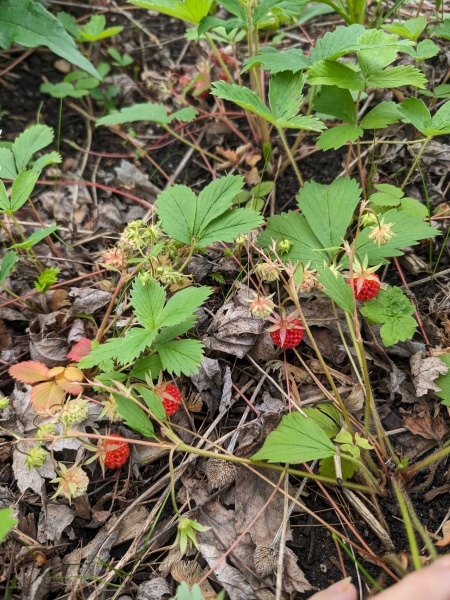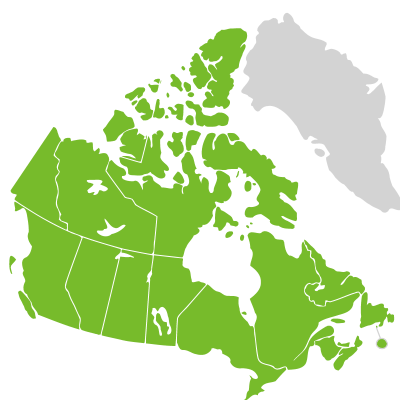
Source: OWSL
Fragaria virginiana
Virginia Strawberry
Fraisier des champs
Synonyms
scarlet strawberry
thick-leaved strawberry
wild strawberry
fraise des champs
fraisier de Virginie
No seeds available for this plant.
We currently accept seeds for this plant
Bloom Colour: White
Bloom Period: Apr - May
Max Height: 0.5 feet
Max Width: 0.5 feet (spreads by rhizome)
Light Condition:
 More than 6 hours of direct sun a day
More than 6 hours of direct sun a day
 More than 2 or 3 hours but less than 6 hours of direct sun a day
Soil conditions:
More than 2 or 3 hours but less than 6 hours of direct sun a day
Soil conditions:
 Tolerates medium soil condition
Tolerates medium soil condition
 More than 6 hours of direct sun a day
More than 6 hours of direct sun a day
 More than 2 or 3 hours but less than 6 hours of direct sun a day
More than 2 or 3 hours but less than 6 hours of direct sun a day
 Tolerates medium soil condition
Tolerates medium soil condition
Lifespan:
Perennial
plants that will that come back year after year
Gardener Experience:
 Self-seeding
Self-seeding
 Self-seeding
Self-seeding
Landscape Uses:
 Suitable for rock gardens
Suitable for rock gardens
 Suitable for Right of Way gardens
Suitable for Right of Way gardens
 Suitable for rain gardens
Suitable for rain gardens
 Suitable for container garden
Suitable for container garden
 Suitable for school gardens
Suitable for school gardens
 Suitable for ground cover
Suitable for ground cover
 Tolerates boulevard garden conditions
Tolerates boulevard garden conditions
 Suitable for rock gardens
Suitable for rock gardens
 Suitable for Right of Way gardens
Suitable for Right of Way gardens
 Suitable for rain gardens
Suitable for rain gardens
 Suitable for container garden
Suitable for container garden
 Suitable for school gardens
Suitable for school gardens
 Suitable for ground cover
Suitable for ground cover
 Tolerates boulevard garden conditions
Tolerates boulevard garden conditions
Ecological Benefits:
 Supports birds
Supports birds
 Supports pollinators
Supports pollinators
 Butterfly host
Butterfly host
 Supports birds
Supports birds
 Supports pollinators
Supports pollinators
 Butterfly host
Butterfly host
Tolerates:
 Tolerates drought conditions
Tolerates drought conditions
 Tolerates salt conditions
Tolerates salt conditions
 Tolerates foot traffic around the plant
Tolerates foot traffic around the plant
 Tolerates limestone conditions
Tolerates limestone conditions
 Tolerates sandy conditions
Tolerates sandy conditions
 Tolerates juglone conditions
Tolerates juglone conditions
 Tolerates drought conditions
Tolerates drought conditions
 Tolerates salt conditions
Tolerates salt conditions
 Tolerates foot traffic around the plant
Tolerates foot traffic around the plant
 Tolerates limestone conditions
Tolerates limestone conditions
 Tolerates sandy conditions
Tolerates sandy conditions
 Tolerates juglone conditions
Tolerates juglone conditions
Special Features and Considerations:
Plant Location
Native to Ottawa region: Yes
Distribution according to VASCAN

Ephemeral
Native
Introduced
Excluded
Extirpated
Doubtful
Absent
Thrives in Ecozones
- Taiga Plains
- Atlantic Maritime
- Taiga Shield
- Boreal Plains
- Montane Cordillera
- Prairies
- Hudson Plains
- Boreal Shield
- Pacific Maritime
- Mixed Wood Plains
Ecological Benefits
Butterflies Supported by Fragaria virginiana
- Olethreutes permundana (Raspberry Leafroller)
- Pyrrhia exprimens (Purple Lined Sallow)
- Xestia smithii (Smith's Dart)
Specialized Bees Supported by Fragaria virginiana
No bee data available for this plant.
Plants that grow in similar conditions, that bloom at the same time.
Complementary Plants
- Antennaria howellii
Howell's Pussytoes
Antennaire de Howell - Antennaria parlinii
Parlin's Pussytoes
Antennaire de Parlin - Plantago rugelii
Rugel's Plantain
Plantain de Rugel - Sisyrinchium angustifolium
Narrow-leaved Blue-eyed Grass
Bermudienne à feuilles étroites - Sisyrinchium montanum
Strict Blue-eyed-grass
Bermudienne montagnarde
Substitute For Non-Native Plants
- Ajuga reptans (Bugleweed)
- Lysimachia nummularia (Creeping Jenny)
- Vinca major and Vinca minor (Periwinkle)
- Hedera helix (English Ivy)
- Glechoma hederacea (Creeping Charlie)
Sowing Information
Download Seed Envelope Labels (PDF)
- Sowing depth: Sow just below surface
- Sow by February
- Stratification duration: 60 days
- Self-seeding
- Notes: Soak for 12h.
Harvesting and Seed Sharing
- Harvest start month: June
- Harvesting indicator:
- Berries are ripen and easily fall off or have fallen off
- Harvesting:
- Squeeze berries to extract seeds, wash with soapy water to remove flesh, rinse throroughly using a strainer
- Seed viability test:
- No test needed before donating
- Packaging measure: 1 rounded 1/32 teaspoon
- Seed storage:
- Keep moisten and cool, in a ziploc bag, in the fridge, with the seeds in soil, paper towel or coffee filter, until donation
- Cultivar: Yes, do not donate unless you know source, and there are no known cultivars in your garden or at proximity
- Remove non-seed material
- No harvesting video available at this time.
Toxicity Notes
Not toxic as per ASPCA.


 Canadensis
Canadensis
